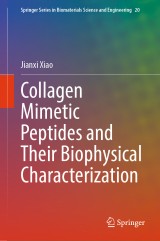Details

Collagen Mimetic Peptides and Their Biophysical Characterization
Springer Series in Biomaterials Science and Engineering, Band 20
|
CHF 118.00 |
|
| Verlag: | Springer |
| Format: | |
| Veröffentl.: | 05.08.2024 |
| ISBN/EAN: | 9789811019418 |
| Sprache: | englisch |
Dieses eBook enthält ein Wasserzeichen.
Beschreibungen
<p>This book embarks on an enlightening journey through the molecular landscape of collagen mimic peptides, shedding light on their significance and potential. In the intricate realm of biomolecules, collagen's preeminence as the most abundant protein in the human body, forming the foundational scaffolding of tissues and organs, renders it a subject of profound scientific interest. It explores diverse facets related to collagen mimic peptides, spanning aspects such as bioinformatic analysis, synthetic strategies, pathological collagen targeting, and the construction of homotrimeric, heterotrimeric and self-assembled peptide models. Furthermore, it provides an exhaustive investigation into biophysical techniques, encompassing Circular Dichroism (CD), X-ray crystallography, Nuclear Magnetic Resonance (NMR), Fluorescence, and Raman spectroscopy, thereby empowering researchers to unravel the structural intricacies of these peptides. The book unravels the profound implications of collagen mimic peptides across a spectrum of scientific domains, including protein science, biomaterials, bioanalysis, and beyond. Its accessibility and insights cater not only to seasoned researchers but also to undergraduate and graduate students eager to delve into the complexities of this fundamental protein.</p><br><p></p>
<p>Introduction to collagen.- Structure of collagen triple helix.- Bioinformatics-aided Design of collagen mimic peptides.- Synthesis of collagen peptides.- CD characterization of triple helix stability.- Structural insights from X-ray crystallography.- Conformational and dynamic characterization by NMR spectroscopy.- Fluorescence detection of collagen biomarkers.- Synthesis and characterization of heterotrimeric models of collagen.- Self-assembly of collagen mimic peptides.- Concluding remarks.</p>
<p>Dr. Jianxi Xiao received his bachelor's degree from Wuhan University in 2003 and completed his Ph.D. at Rutgers University-New Brunswick, New Jersey, in 2009. He pursued postdoctoral research at Rutgers University and subsequently attained a full professorship at Lanzhou University's College of Chemistry and Chemical Engineering in 2012. Dr. Xiao holds the distinguished title of Cuiying Scholar at Lanzhou University and is honored with the prestigious "Feitian Scholar" professorship in Gansu Province. In addition, he serves as Director of Medical Collagen Engineering Research Center in Gansu Province and as Director of Joint Collagen Research Center at Lanzhou University. His research interests encompass the development and characterization of innovative collagen mimic peptides, collagen-targeting peptide probes, and collagen-based biomaterials. Dr. Xiao's extensive work has significantly advanced our comprehension of collagen's structure, function, and pathology, leading to the publication of over 70 academic papers in esteemed journals.</p>
<p> </p>
<p> </p>
<p> </p>
<p> </p>
<p> </p>
<p> </p>
<p>This book embarks on an enlightening journey through the molecular landscape of collagen mimic peptides, shedding light on their significance and potential. In the intricate realm of biomolecules, collagen's preeminence as the most abundant protein in the human body, forming the foundational scaffolding of tissues and organs, renders it a subject of profound scientific interest. It explores diverse facets related to collagen mimic peptides, spanning aspects such as bioinformatic analysis, synthetic strategies, pathological collagen targeting, and the construction of homotrimeric, heterotrimeric and self-assembled peptide models. Furthermore, it provides an exhaustive investigation into biophysical techniques, encompassing Circular Dichroism (CD), X-ray crystallography, Nuclear Magnetic Resonance (NMR), Fluorescence, and Raman spectroscopy, thereby empowering researchers to unravel the structural intricacies of these peptides. The book unravels the profound implications of collagen mimic peptides across a spectrum of scientific domains, including protein science, biomaterials, bioanalysis, and beyond. Its accessibility and insights cater not only to seasoned researchers but also to undergraduate and graduate students eager to delve into the complexities of this fundamental protein.</p><br><p></p>
Addresses every important aspect of collagen mimic peptides Introduces the latest studies on both homotrimeric and heterotrimeric collagen peptides Provides protocols for studying thermal stability, structure, dynamics, and quantitative detection of collagen peptides
<p>This book embarks on an enlightening journey through the molecular landscape of collagen mimic peptides, shedding light on their significance and potential. In the intricate realm of biomolecules, collagen's preeminence as the most abundant protein in the human body, forming the foundational scaffolding of tissues and organs, renders it a subject of profound scientific interest. It explores diverse facets related to collagen mimic peptides, spanning aspects such as bioinformatic analysis, synthetic strategies, pathological collagen targeting, and the construction of homotrimeric, heterotrimeric and self-assembled peptide models. Furthermore, it provides an exhaustive investigation into biophysical techniques, encompassing Circular Dichroism (CD), X-ray crystallography, Nuclear Magnetic Resonance (NMR), Fluorescence, and Raman spectroscopy, thereby empowering researchers to unravel the structural intricacies of these peptides. The book unravels the profound implications of collagen mimic peptides across a spectrum of scientific domains, including protein science, biomaterials, bioanalysis, and beyond. Its accessibility and insights cater not only to seasoned researchers but also to undergraduate and graduate students eager to delve into the complexities of this fundamental protein.</p>
<p> </p>
<p> </p>

















